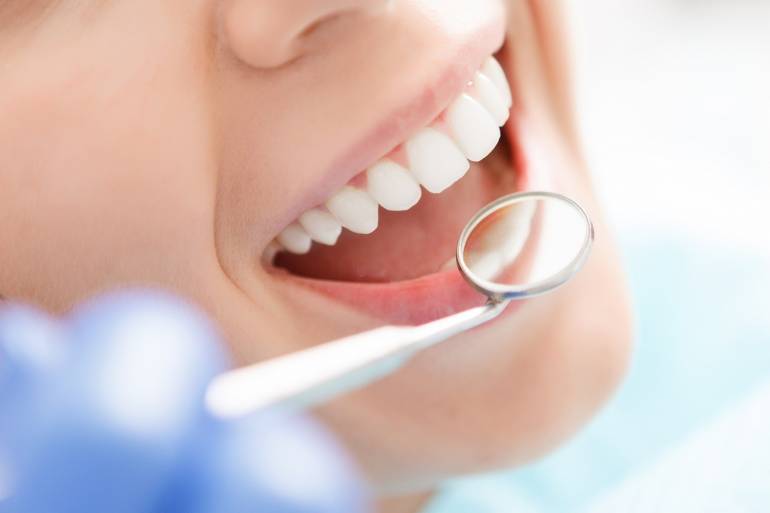Wondering if you might also be affected by oral problems? To find out, you should answer some basic questions about the health of your teeth and possible dental problems.
Recognition of oral problems (questions):
- Do you experience pain in your gums and teeth? How often do they occur?
- Are you worried about bleeding gums? Do they bleed spontaneously or during brushing when you accidentally damage them?
- Are you impatient with experiencing discomfort while wearing dentures?
- Are you observing white-yellow and often painful lesions in the oral cavity (on the inside of the cheeks, or around the gums)? The gums surrounding the “growing area” of the teeth are receding, making the roots of the teeth visible?
It is worth finding out why annoying changes can occur in the mouth and how to reduce the discomfort associated with them.
Pain in the mouth – what can it result from?
We often downplay pain in the oral area, being unaware of the possibly serious causes of its occurrence. Let’s consider in what situations we may experience pain in the oral area and whether it may require medical intervention.
Toothache can cause:
- Inflammation of the gums (periodontitis),
- Damage to nerves located in the oral cavity,
- enamel fracture,
- caries,
- Tooth sensitivity – usually to acidic, cold or hot products,
- atrophy of the gums (and thus exposing the necks of the teeth, and exposing the roots of the teeth to external factors, including, above all, the entry of pathogenic microorganisms),
- tooth loss,
- an improperly performed dental procedure, during which the dental pulp (that is, the structure filling the inside of the teeth, containing numerous blood vessels and nerve endings) was irritated.
In the case of gum pain, infectious diseases of the gums (gingivitis), mechanical damage (wounds, cuts), or the formation of sores from dentures should be mentioned as the main causes.
Often, experiencing pain in the mouth, we also observe whitish plaques on the inside of the cheeks, or on the gums. These plaques signal an infection (viral, bacterial or fungal).
Paradontosis – what is it and how does it manifest itself?
Paradontosis is periodontitis (periodontal infection). It is a consequence of inflammation of the gums, during which bacteria multiply within the tartar. Paradontosis should not be underestimated, as it can lead to tooth loss.
Dentures and the problems they can cause
Dentures (commonly referred to as artificial jaws) are permanent or removable replacements for missing teeth. Although dentures are mainly associated with elderly people who have lost some or all of their teeth, they are not only for them. Dentures are also used for young people who have suffered irreparable damage to their teeth. Dentures are also used in a “rescue” form for healthy teeth that are in danger of growing out abnormally (in which case the tooth blocking the proper outgrowth of adjacent teeth is removed and a denture is inserted to replace the removed tooth). In addition, dentures restore proper function, that is, they allow chewing, biting, speaking and natural mouth positioning, and protect the jawbone from deformation and atrophy.
The most common problem for denture wearers is the fact that they wobble, become loose and seem to “fall out”. This happens when the dentures are inaccurately fitted, or put on before the wounds from tooth extraction have healed (so-called direct full dentures, which require adjustment, after several months of use).
Another problem is bedsores. Bedsores are damage to the skin along with the tissues underneath, extending all the way to the bone. The cause of bedsores is prolonged pressure, consequently leading to tissue hypoxia and necrosis. You can protect yourself from sores resulting from an ill-fitting denture. First of all, you need to inform your dentist (prosthodontist – denture specialist) about the pressure you feel and try to readjust the denture. This may involve sawing, trimming the bracket, or polishing the denture plate. Of course, it is not worth doing this kind of procedure yourself, as the denture is a delicate item and can be easily damaged.
If sores have already developed, it is worth using a gel that accelerates wound regeneration (such as Mucosit).
How can you protect yourself from oral ailments?
There are simple ways to deal with pain and gingivitis. Taking care of oral hygiene, is the basis for the prevention of gum and periodontal disease. Without a doubt, teeth should be brushed thoroughly, at least twice a day (and preferably after every meal), flossed, and the mouth rinsed with a specialized liquid. Thanks to such procedures, we will stop the proliferation of bacteria in the mouth.
Sometimes, however, even regular hygiene treatments are not enough, in which case it is worth considering medicinal preparations.
How to respond to oral pain complaints?
We usually consider two options – self-medication for gum pain or a visit to the dentist. It is important to remember that the first solution, over-the-counter (OTC) medications, should only be a temporary measure to reduce the nagging symptoms. Even if the pain subsides you need to visit your doctor to determine the source of the problem.
What preparations can be used for oral ailments?
Sometimes it seems easiest to reach for oral pain medication in pill form. A far better option would be a medication in gel form, which allows topical application, that is, in the area where the problem is. There are also preparations containing natural herbs for gum pain.
What composition should characterize a good preparation for oral ailments?
The oral preparation should be distinguished by its analgesic or anesthetic effect, as well as soothing irritation, eliminating swelling, stopping bleeding, protecting against the development of infection and accelerating wound healing.
The effect of stopping bleeding, otherwise astringent, is obtained through the use of oak bark extract. Anti-inflammatory properties are the domain of plant extracts of chamomile, calendula and coltsfoot. Protection against bacterial penetration can be provided by thyme and sage extracts. An analgesic effect can be achieved through the use of peppermint oil, which is due to the feeling of coolness after application of the gel. Additional anesthetic effect can be provided by the use of lidocaine. Meanwhile, acceleration of wound healing, astringent and anti-inflammatory effects characterize allantoin, which should also be included in the composition of a good preparation for oral ailments.
Mucosit – comprehensive help for periodontal inflammation
Mucosit is a drug in the convenient form of a gel for topical application on the gums. The rich composition of the preparation ensures effectiveness in the treatment of inflammation in the gums and periodontium. Mucosit gel is characterized by all the above-mentioned actions – astringent, anti-inflammatory, antibacterial, local anesthetic and accelerating wound healing, so it can be described as an effective preparation for use in all oral ailments.
When to use Mucosit gel?
Mucosit gel can be used for inflammation of the gums, bleeding gums, soreness of the gums and oral mucosa, as well as sores resulting from the wearing of dentures.
How to use Mucosit gel?
It is important to maintain the correct way of applying Mucosit gel. In the first step, brush the teeth thoroughly. Then, with a clean fingertip, or a cotton swab, rub 1-2cm of gel for about three minutes. This procedure should be repeated on average two to three times a day.
During therapy with Mucosit gel, it is necessary to maintain attention to oral hygiene. Only regular hygiene procedures (brushing, flossing and rinsing with specialized liquids) can prevent recurrence of the condition. Also important are regular check-ups with the dentist, who can offer more extensive specialized treatment.
Can anyone use Mucosit gel?
The drug Mucosit is intended for adults and adolescents over 12. year of age. It should not be used by people who take oral anticoagulants (otherwise known as anticoagulants, including warfarin). The use of Mucosit gel is also contraindicated in people who have hypersensitivity to the ingredients it contains.







